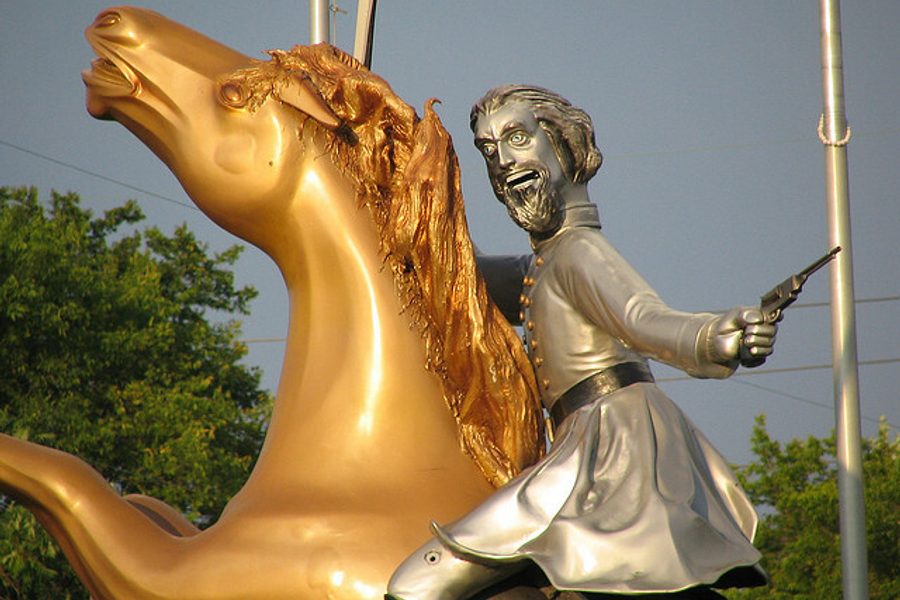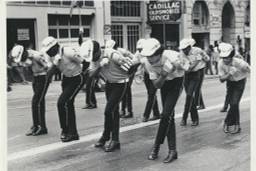After the Confederate Flags Come Down, Everything Named After Nathan Bedford Forrest Should Be Next
The Confederate general and KKK “grand wizard” belongs on the short list of the most vile white supremacists in American history. Yet parks and monuments in his name can be found throughout the South.
Peter Cole

After Dylan Roof’s recent racist massacre in Charleston, South Carolina, the vision of white supremacy that lay at the core of the Confederate flag has been widely discussed, even leading to Gov. Nikki Haley calling for the long-overdue removal of the flag from the South Carolina State Capitol. Black Lives Matter protesters have also defaced monuments to the Confederacy throughout the South. Such shrines to white supremacy are heinous, and activists are right to go after them.
But if those activists want to target a particularly vicious symbol of white supremacy whose name can still be found in public spaces around the South but especially Tennessee, they should go after our country’s many monuments to Nathan Bedford Forrest, the Confederate general who committed the single worst atrocity of the Civil War — the Fort Pillow massacre, brutally murdering hundreds of African-American and white Union soldiers who had already surrendered — and then became the first national leader of the Ku Klux Klan.
Now is the time to rename every single park, school and building named after him, and to remove every statue and plaque honoring him from any public venue, in America.
A history of vicious white supremacy
The first park named after Nathan Bedford Forrest I ever encountered was in Memphis, Tennessee. Upon realizing where the park’s name came from, I looked around incredulously, feeling like somehow, someone was playing a joke on me. Surely, this despicable man could not have this incredible public space named after him along with a statue suggesting his nobility?
I’m a professor of American history specializing in race relations. I am under no illusions that racism is dead in America. But I had no idea that there were places named after Nathan Bedford Forrest. No doubt, many Americans today — from across the racial and ethnic spectrum — are unaware of who this person was and why we should no longer honor him.
Before the Civil War, Forrest became fabulously wealthy in the cotton industry: buying and selling black slaves and using them to grow cotton — blood money, plain and simple. When the “War Between the States” broke out, Forrest joined a Confederate outfit as a private and quickly moved up the ranks, eventually becoming a general.
In 1864, Forrest’s soldiers captured Fort Pillow, located beside the Mississippi River in western Tennessee, along with its garrison of former black slaves and white Southern unionists; in fact, many Southern whites, especially from the Appalachian region, were pro-Union and hundreds of thousands fought for the Union. Though these men had surrendered, Lieutenant General Forrest and his troops murdered more than 300 Union soldiers, about half of whom were former slaves and the other half whites from eastern Tennessee.
According to Forrest’s own initial report, the river was “dyed with the blood of the slaughtered for 200 yards.” His field commander bragged that his men had taught “the mongrel garrison” a memorable lesson. Forrest and his staff later denied a massacre had occurred, but their own words suggest otherwise: “ ‘It is hoped,’ the general proclaimed in his post-battle report, ‘that these facts will demonstrate to the Northern people that Negro soldiers cannot cope with Southerners.’ ”
After the war ended in 1865, a group of Confederate veteran soldiers formed a social club, the Ku Klux Klan, that almost immediately morphed into a white supremacist group aiming to roll back progressive Reconstruction governments. Southern whites could not prevent the abolition of slavery, enacted in the 13th Amendment to the Constitution, in late 1865. However, they created the Klan and many other similar groups in an attempt to prevent African-American advancement. Forrest soon served as the Klan’s first Grand Wizard, the head of the entire group that proclaimed itself “The Invisible Empire of the South.”
In the late 1860s and early 1870s, during the era called Radical Reconstruction, a series of incredible victories occurred, most importantly the ratification of the 14th Amendment (which ensured equal protection under the law for all U.S. citizens, including black people) and 15th Amendment (which granted black men the right to vote while still excluding women from this basic right). Such dramatic and rapid progress towards interracial equality enraged many Southern whites still unwilling to accept defeat.
Along with other white supremacist organizations including the White League and Knights of the White Camelia, the Klan engaged in systematic campaigns across the former Confederacy to terrorize African-American citizens. Many thousands of black men and women, along with some white men (members of the Republican Party, then the liberal party and committed to racial equality) were murdered by these organizations. For every person shot, lynched, stabbed or dragged behind a horse, hundreds of other blacks took heed of that lesson: Most whites refused to accept black people as their equals and would employ terroristic violence in order to defend white supremacy.
The Klan’s reign of terror became so awful that, in 1871, the U.S. Congress passed the Ku Klux Klan Act that empowered the U.S. president to dispatch soldiers to attack domestic terrorist organizations. President and former Union General Ulysses S. Grant sent Army soldiers against the Klan and quickly defeated them. The federal government did what southern governors and mayors could not or would not do: protect African American lives.
For complicated reasons, including their own racism, in the mid-1870s white Americans around the nation grew weary of protecting black lives. No president ever used the power of the KKK Act again. The Klan soon disappeared, though, because in 1877 America’s incredible experiment in interracial democracy ended as part of a compromise to resolve the nation’s most corrupt and controversial presidential election. It would take another century to fulfill “America’s unfinished revolution,” as the great historian Eric Foner subtitled his magisterial work on the Reconstruction period.
The Klan briefly disappeared, only to be resurrected in 1915 because of a resurgence of white Americans’ fear and hatred of African Americans, along with Catholic and Jewish European immigrants. The Klan was brought back to life by fans of the single-most popular film of the “silent film” era, Birth of A Nation.
Moreover, the name of Nathan Bedford Forrest lived on in many Southern locales — shepherded, not coincidentally, by groups made up of the children of Confederate veterans.
Forrest in Tennessee
Tennessee, which happens to be the birthplace of the Ku Klux Klan as well as Forrest, has multiple sites named after him though there is no definitive list of Confederate monuments. In addition to the aforementioned Memphis park, the ROTC building at Middle Tennessee State University is named after Forrest. Most conspicuously, a large state park in southeastern Tennessee was named after Forrest when built — with federal money, ironically — during the Great Depression; that this park was named after Forrest also is tragic because the white soldiers killed at Fort Pillow were from eastern Tennessee. The official Tennessee state park website nods vaguely to this racist history stating, “Although a controversial figure, Forrest is remembered by some as a noted military tactician of the Civil War.” It was named a state park in 1963 — the same year that Dr. Martin Luther King, Jr., delivered his “I Have A Dream” speech. No doubt, there are other monuments to this man in Tennessee and elsewhere.
Recent years have seen growing number of Americans, black and white, call for Forrest’s name and visage to be removed from public places.
In 2014, a Florida public high school founded in 1959 (five years after Brown v. Board of Education outlawed racial segregation in public schools) was renamed Westside High School. The school board had resisted efforts to rename the school from Nathan B. Forrest High School as recently as 2007. The school’s nickname, the Rebels, also was changed to the Wolverines. Better late than never.
Not surprisingly, African Americans and some white allies in Tennessee are calling for precisely the same thing. In Memphis, where I first saw Forrest’s name on a public space, Mayor A.C. Wharton, Jr., a Democrat and African American, is calling for the removal of Forrest’s statue. In 2013, he helped lead the effort to rename the park, now called Health Sciences Park, as well as his city’s Confederate and Jefferson Davis Parks.
Predictably, as Memphis TV station WREG news reported at the time, “Lee Millar with the Sons of Confederate Veterans strongly opposes the move. ‘He was a city councilman, an alderman for two terms and helped rebuild the city after the war.’ ”
One statue of Forrest that will not be removed was created by one of the lawyers who represented the man who murdered Martin Luther King, Jr. This notorious racist designed this macabre statue that looms 25-feet over I-65 in Nashville — on private property owned by a man who embraces Forrest and flies many a Confederate battle flag on his land.
Other Tennessee Democrats are calling for the removal of Forrest’s bust from the State Capitol along with the name of the state park in eastern Tennessee. “Why would we celebrate anything that produced evil?” State Rep. Johnny Shaw, a Democrat from Bolivar, said. “It is a celebration of evil,” he said.
Sadly and not surprisingly, the Republican state senator from eastern Tennessee, John Stevens, dissented. “The controversy about Forrest’s name and likeness comes from people trying to politicize the shootings in Charleston. Beyond that, Stevens said the history of the state is its history and removing it would be a form of fascism.”
Stevens does not seem to know of the Fort Pillow Massacre, but assuming State Senator Stevens knows what fascism means, his use of the term adds further irony: labeling as fascists those trying to cease honoring a fascist.
It’s a clever rhetorical ploy, but it won’t work this time. Momentum is building to attack these overt symbols of hatred and racism, of domestic terrorism that dot the South and the rest of the U.S. Nathan Bedford Forrest’s name should be at the top of any such list of such symbols that need to be removed immediately.







